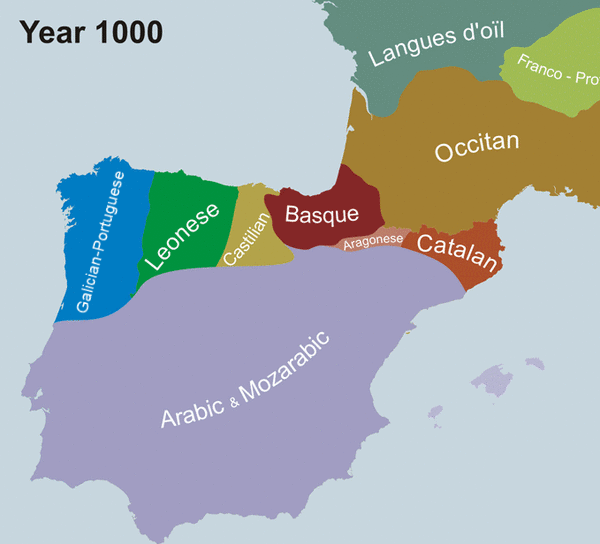As anything that’s been around for 1,500+ years does, the Spanish language has a rich and complicated history. It has navigated the rise and fall of great empires, has been a symbol of cultural identity, and has both been used as a tool of unity and caused considerable divisiveness. Today, it is the world’s second-most spoken native language and is used by people in all corners of the globe to express themselves. This fact makes Spanish a popular choice to learn, as native speakers are never too far away!
Origins in Latin
Spanish originated in the Iberian Peninsula as a dialect of spoken Latin, which is today called “Vulgar Latin,” as opposed to the Classical Latin used in literature. The dialect of Spanish that we consider dominant in Europe is called Castellano or Castilian Spanish.
During the Roman Empire, the Latin language was the official language on the peninsula (called “Hispania”), but it mixed with the local languages of the inhabitants, including Celts and Iberians, and began to take on its own unique flavor.
The germination of this uniqueness was accelerated by the Visigoths, a Germanic group that conquered areas of the peninsula in the 4th century during the demise of the Roman Empire. The Visigoths spoke Latin at this time, and rather than a Germanic influence on the language, their main influence was of cultural depression on the peninsula, causing the form of Vulgar Latin spoken to develop in isolation in the 5th century. This is where historians and linguists pinpoint the beginnings of the Spanish language as we know it today.
Following the Visigoths, Muslim Moorish conquerors arrived and contributed more than 4,000 Spanish words from Arabic, along with cultural influences still evident in the design, art, and architecture of Spain. Adopted words from Arabic lost their original pronunciation, however, so the overall sounds or phonology of Spanish was surprisingly not heavily influenced by Arabic.
Castellano
The Reconquista period (between 711 and 1492) refers to the slow reconquering of present-day Spain from the Moors by the Kingdom of Castile (with the help of other allied kingdoms). Castilian Spanish was further popularized by the narrative poems spread orally about Castilian heroes in battle. These were recited even in areas that did not speak this dialect (people were short on entertainment back then).
In the 13th century, King Alfonso X of Castile, known as Alfonso el Sabio (Alfonso the Wise), assembled scribes in his courts of Toledo to document various subjects such as astronomy, law, and history, including translation of classical literature into Spanish. You could say that King Alfonso X was wise to the fact that written language was all the rage, and that commissioning works to be written in his native Castilian before a similar effort was undertaken somewhere else would ensure his language (and therefore influence… and therefore power) would remain prominent. This was a genius marketing move for Castilian Spanish. This solid basis of written Castilian Spanish facilitated the spread of the language during the Reconquista.
The next monarchs of the Kingdom of Castile, Isabella and Ferdinand, were extremely influential in the course of the history of Spanish. Isabella was the queen of Castile and Ferdinand was the King of Aragon. Both kingdoms didn’t become one right away, but “it is generally accepted by most scholars that the unification of Spain can essentially be traced back to the marriage of Ferdinand and Isabella.” Under their rule, the Castilian variety of Spanish was made the official language of all the “re-conquered” territories. They supported Antonio de Nebrija’s publication of Arte de la Lengua Castellana (The Art of the Castilian Language), the first attempt to define the grammar of a European language. Their imperial efforts also imposed Spanish on the natives of their American colonies.

Learn Spanish with Lingvist
Learn the words you actually need, when you need them!
Royal Spanish Academy
The Royal Spanish Academy, or Real Academia Española, was founded in 1713, mainly with the purpose of standardizing the language. For example, it did future Spanish learners a big favor by standardizing the use of accents to denote syllabic stress that does not follow the pronunciation rules (see Spanish pronunciation).
Between 1726–1739 it produced its first dictionary (in six volumes). It’s still the authoritative source on Castilian Spanish today, reporting an estimated 93,000 words in its latest edition (2014). Because the language differs so much internationally, other Spanish-speaking countries have their own academies to keep tabs on their regional features.

Learn Spanish vocabulary
Quickly learn new words and review existing vocabulary
in real-world contexts
Regional Languages of Spain
 The original uploader was Alexandre Vigo at Galician Wikipedia.
The original uploader was Alexandre Vigo at Galician Wikipedia.
Present-day Spain is home to several regional languages: Castilian (spoken by 99% of the population), Catalan (spoken by 19% of the population), Galician (spoken by 5% of the population), and Basque (spoken by 2% of the population). In some cases, these languages are not mutually intelligible for speakers, meaning that they can’t understand each other without some difficulty. For example, the Basque language did not originate from the same language family as Spanish, and so it cannot be considered a dialect of Spanish. Today, Spaniards use Castilian Spanish as their lingua franca, but they use their regional language in their everyday lives and, in some cases, in schools and business.
During the Second World War, the dictator Francisco Franco declared Castilian Spanish Spain’s only official language, prohibiting the use of other regional languages in many areas. As you might imagine, this caused turmoil in regions which identified more strongly with their regional heritage and local language than with the growing Spanish nationalistic fervor. The regime referred to these other languages as “dialects” of Spanish in a derogatory way – claiming that they were inferior and lacking, and therefore unfit for official use. The concept of “dialect” itself is very controversial and often has as much to do with historical and political implications as it does with linguistic tenets. As the old adage states: “A language is a dialect with an army and a navy.” In this case, the reference to the regional languages of Spain as “dialects” had a strong nationalistic (unifying) motivation. Foreign films were dubbed into Castilian or forced to be reissued in Castilian if originally filmed in a regional language. Non-Castilian names were even banned for newborns in 1938.
In the 1960s and 1970s, the Spanish parliament agreed to allow regions to print official documents in their regional languages, and today the use of local languages is no longer illegal. There is no doubt, though, that this historical period influenced the spread and status of Castilian Spanish. This recent cultural stifling still informs the identities of many people living in these regions in Spain. Visitors to Spain may notice a strong allegiance to regional identity and pride in local heritage as a consequence of this historical tension.
Spanish in the Americas
Latin America
Spanish colonization brought the language to the Americas beginning in 1492. Today, “Latin America” refers to countries that were subject to Spanish, French, and Portuguese imperialism and therefore still speak a Latin-based language. As a result of Spanish colonialism in Latin America and a few other areas of the globe, Spanish is the official language of 20 countries today (plus one territory: Puerto Rico) and is spoken by 400 million native speakers worldwide. Spanish colonies fought for their independence from Spain throughout the 18th century but maintained Spanish as their official language. Many of these new Latin American governments encouraged use of Spanish by the Amerindian majority to promote national unity following independence.
United States
The first European settlement in the present-day United States was actually established by Spain in what is now Florida. Spanish was the historical language of many current US states while controlled by the Spanish or Mexican governments. The gradual annexation of southwestern states changed the official language to English, but Spanish is still spoken by large portions of the populations in these areas today.
Researcher Rosino Lozano, author of An American Language: The History of Spanish in the United States, discusses how the transition from Spanish as an official language of territories in the American southwest stirred political tumult with the insinuation by many in power that these new territories couldn’t be both Spanish-speaking and American. Language rights are still a complicated issue in the United States and continue to be a subject of debate. Although English is the only official language of the United States, government documents are still provided in Spanish in several states, such as in New Mexico and California. Spanish is also the most widely taught second language in the United States. In the Commonwealth of Puerto Rico, Spanish retains its status as the official language.
Old Spanish versus Modern Spanish
It may surprise you to know that Shakespeare’s English was considered Modern English – that’s how much a language can change over the years! Unlike Old English or Middle English, Old Spanish is relatively easy for a Modern Spanish (from the 16th century on) speaker to interpret. The possibility to read original medieval artifacts and ancient texts is a rare opportunity for language learners, which is usually complex even for native speakers.
For many, Spanish is the language of love. You can find it as a common topic in music, books or movies. A classic book, considered the first modern novel in Spanish, is The Ingenious Gentleman Don Quixote of La Mancha, a story full of adventure and love. You can find here a blog post that can help you read and understand Don Quixote in Spanish.
Looking to improve your Spanish? Lingvist is the fastest way to learn Spanish vocabulary and Lingvist’s Spanish course has more than 5,000 words!




